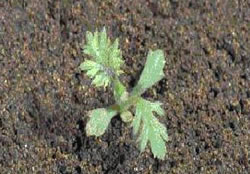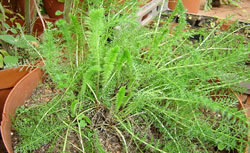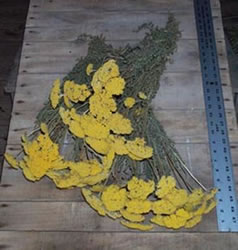Uses
Yarrow is a very valuable medicinal herb, with much scientific evidence of use in alternative medicine as an antiseptic, antispasmodic, astringent, carminative, diaphoretic, digestive, emmenagogue, stimulant, and tonics, vasodilator and vulnerary. Yarrow is used against colds, cramps, fevers, kidney disorders, toothaches, skin irritations, and haemorrhages, and to regulate menses, stimulate the flow of bile, and purify the blood. Medicinal tea is a good remedy for severe colds and flu, for stomach ulcers, amenorrhea, abdominal cramps, abscesses, trauma and bleeding, and to reduce inflammation. The main constituents are volatile oils including linalool, camphor, sabinene, and chamazulene, sesquiterpene lctones, flavanoids, alkaloids including achilleine, polyacetylenes, triterpenes, salicylic acid, coumarins, and tannins, which prove these uses in alternative medicine to be effective. Extracts of yarrow exhibit antibiotic activity and may also act as anti-neo plastic drugs. Externally for treating wounds and stopping the flow of blood. Yarrow oil has been traditionally used in hair shampoos.
Planting

Sow spring or early autumn. Germination takes 20-45 days at soil temperature of 60-65F Sowing depth: Surface Sow Kind of soil: Yarrows grow aggressively. Give them well-drained soil with a pH around 6.4 and low fertility. Well drained, average to poor soil. If the soil is too fertile, the plants will require netting for support. Rows: 1-3 feet apart. Close spacing produces a high yield per square foot, but a low yield per plant. Keep moist until germinated.
Growing

Yarrow can endure dry, impoverished soil and survive with little maintenance. Requires full sun. A handful of bone meal in May will promote growth. Phosphorus and potassium: on soils with an intermediate phosphorus and potassium content, basic fertilization with manure (15-25 tones/ha solid or liquid manure) is sufficient in autumn. For mineral fertilization 40-60 kg/ha P(2)O(5) and 60-100 kg/ha K(2)O are recommended. Nitrogen: a sufficient supply of nitrogen in autumn guarantees satisfactory tilling. The following amount is necessary for seed formation: 50-60 kg/ha of N-total to be added in autumn and early spring.
Watering Schedule
| Time | Pivot % | How long? |
| 1st 3 weeks after planting | 100%, 5-7m per watering | 1 to 2 times /day depending on day time heat and evaporation |
| Week 4 to picking | 100%, 5-7m per watering, 2 to 3 times per week | As required use discretion-soil must remain moist at all times |
| Picking | once per week | As required |
Harvesting

When yarrow is in full bloom, feel it and on the day the umbel changes from a soft to a stiff texture is the day you should cut. Resistance to lodging: high. Shattering tendency: low. Hang Yarrow upside down in dry, dark, open and airy place to dry. The essential oil is produced by steam distillation from dried yarrow flowers . It is necessary to leave the distillation area during extraction.

 Proud to be
Proud to be